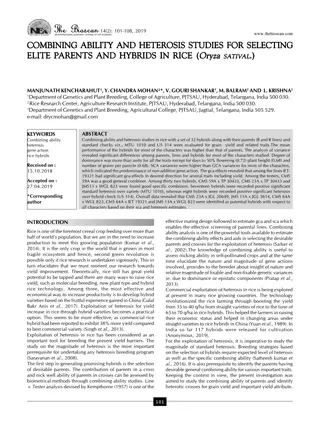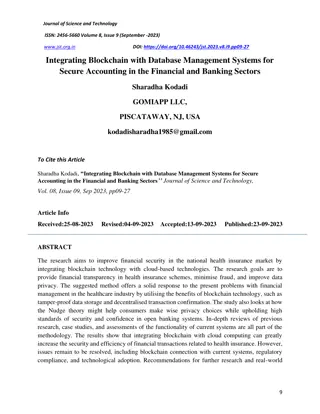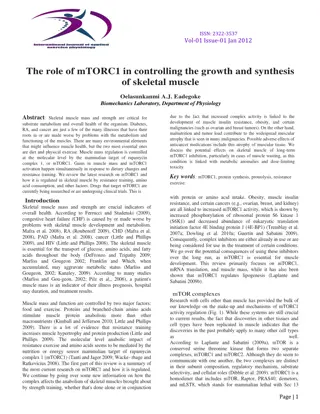
journal of life sciences research and reviews
The Journal of Life Sciences Research and Reviews is a scientific journal that typically focuses on publishing articles related to various fields within life sciences. These can include topics such as biology, biotechnology, biochemistry, molecular b
Download Presentation

Please find below an Image/Link to download the presentation.
The content on the website is provided AS IS for your information and personal use only. It may not be sold, licensed, or shared on other websites without obtaining consent from the author. If you encounter any issues during the download, it is possible that the publisher has removed the file from their server.
You are allowed to download the files provided on this website for personal or commercial use, subject to the condition that they are used lawfully. All files are the property of their respective owners.
The content on the website is provided AS IS for your information and personal use only. It may not be sold, licensed, or shared on other websites without obtaining consent from the author.
E N D
Presentation Transcript
Journal of Science and Technology ISSN: 2456-5660 Volume 9, Issue 09 (September -2024) www.jst.org.in DOI:https://doi.org/10.46243/jst.2024.v9.i09.pp01- 06 In vitro antagonistic activity of Plant Growth Promoting Rhizobacterial (PGPR) isolates against mulberry charcoal rot pathogen, Macrophomina phaseolina Maria Joncy Maria Joncy1 | Vanitha S 1 | Vanitha S2 2 | | 1Dept. of Sericulture, Forest College and Research Institute, Tamil Nadu Agricultural University, Mettupalayam, India. 2 Dept. of Plant Pathology, Center for Plant Protection Studies, Tamil Nadu Agricultural University, Coimbatore, India. To Cite this Article Maria Joncy Maria Joncy| | Vanitha S Vanitha S, In vitro antagonistic activity of Plant Growth Promoting Rhizobacterial (PGPR) isolates against mulberry charcoal rot pathogen, Macrophomina phaseolina Journal of Science and Technology, Vol. 09, Issue 09,-Sep 2024, pp01-06 Article Info Received: 07-06-2024 Revised: 15-07-2024 Accepted: 25-08-2024 Published: 03-09-2024 ABSTRACT The charcoal rot caused by Macrophomina phaseolina is the most virulent soil-borne disease in mulberry. Due to the issues of pollution, disparity in soil ecosystem along with possible risks to silkworms, the natural control method known as a promising technique for the management of root diseases. The objective of this study was to evaluate the antifungal efficacy of Plant Growth Promoting Rhizobacteria (PGPR) isolates against M. phaseolina. The charcoal rot causing pathogen, M. phaseolina was isolated from infected mulberry roots and its morphological and microscopical characters were observed. A total of 10 PGPR isolates were purified from healthy mulberry rhizosphere soil and identified isolates were belonging to the genera of Bacillus. The antifungal activity showed that BSSY9 isolate showed maximum growth inhibition of 58.5 % followed by BSKP3 isolate with 54.07%. Hence, this isolates could be useful in developing an eco-friendly root rot management practices. KEYWORDS: Mulberry, charcoal rot, PGPR isolates, Bacillus sp. I.INTRODUCTION The mulberry is an economical, fast growing hardy perennial woody plant belonging to the genus Morus of the family Moraceae (Vijayan et al., 2011). Mulberry is an important crop in the sericulture industry because it serves as the primary food source for silkworms (Altman and Farrell, 2022). Sericulture is the process of rearing silkworms for the production of silk, which is considered as a valuable and luxurious textile (Guo et al., 2019). Therefore, the success of the sericulture industry largely depends on the availability and quality of mulberry as the main food source for silkworms. The major constraints for successful cultivation of mulberry and quality leaf production are insufficient water, poor agrochemical inputs, weeds and the outbreak of pests and diseases. Lately, root diseases are a major problem in mulberry cultivation, as managing them is quite a challenge when compared with foliar diseases. Perennial nature of the crop, resilience of soilborne pathogens, and their persistence in soil as spores and sclerotia provide a congenial atmosphere for the establishment of infectious agents and inoculum build-up (Pinto et al. 2018). Mulberry root rot outbreaks have become a serious threat in four South Indian states Karnataka, Andhra Pradesh, Tamil Nadu and Page | 1
Telangana. These four states cumulatively account for approximately 80% of the mulberry raw silk production in the country (Sowmya, 2018). Various types of root rots have been reported in mulberry (Philip et al.1995; Radhakrishnan et al. 1995; Sridhar et al. 2000). Occurrence of disease complexes due to infection by more than one root rot-causing pathogen and association of root-knot nematode, Meloidogyne incognita with root rot have also been reported (Yadav et al. 2011; Naik, 2006). Hence, it was found that M. phaseolina is the most prevalent pathogen in the South Indian sericulture belt. Most mulberry cultivars are prone to charcoal rot disease and can cause up to 35% leaf yield loss, reduction in leaf size, deterioration of leaf quality, and plant mortality (Chowdary, 2006). Due to environmental pollution issues, imbalance in soil ecosystem as well as potential threat to silkworms the biological control method has been considered as a promising approach for the management of soil borne diseases (Choudari et al., 2012). Plant growth-promoting rhizobacteria (PGPR) are symbiotic and free-living bacteria that live within the plant root and can directly or indirectly promote plant growth (Arruda et al., 2013) PGPR, namely Pseudomonas sp. and Bacillus sp., have shown activity in suppressing the fungal infection (Chen et al., 2000). Recent investigations on mechanisms of biological control by PGPR revealed that several strains protect the plants from pathogen attack by strengthening the epidermal and cortical cell walls with deposition of newly formed barriers beyond infection sites including callose, lignin and phenolics (Benhamou et al., 1996; M Piga et al., 1997) and by activating defense genes encoding chitinase, PO, PPO and PAL (M Piga et al., 1997; Chen et al., 2000) and enzymes which are involved in the synthesis of phytoalexins (Maurhofer et al., 1994). With a view, the present study has been carried out to evaluate the antifungal activity of native isolates of Bacillus sp. for protection of mulberry against root rot pathogen (M. phaseolina) and aiming to develop eco-friendly management strategies for mulberry root rot disease. II.METHODOLOGY Isolation of pathogen, M. phaseolina The root samples were collected from the root rot infected mulberry field and used for isolation of pathogen following root bit method (Naik et al., 2008). Infected portion of root samples were cut into small pieces, surface sterilized with 2 percent sodium hypochlorite solution for 3 minutes and washed with sterile distilled water for about 3-4 times; these root bits were blot dried with Whatman No. 1 filter paper discs and kept on Petri dishes containing sterilized solidified Potato Dextrose Agar (PDA) medium in aseptic conditions. The plates were incubated for 7-8 days at room temperature (27 2 C) and observed at regular intervals. Identification of the pathogen The pathogen isolated from root rot (M. phaseolina) was visually observed for the cultural, morphological and spore characters in the culture media and also observed under microscope. For the identification of the fungus, M. phaseolina was sub cultured on fresh PDA medium. The cultural, morphological and spore characteristics were examined (Dhingra and Sinclair, 1978). Isolation of PGPR isolates from healthy mulberry rhizosphere For isolation of Plant Growth Promoting Rhizobacteria, the healthy mulberry rhizosphere soils were collected from ten villages of Coimbatore district at farmers field. The rhizosphere soil was taken from the root zone in the depth of 10-20 cm. The collected soil samples were packed in sterilized zip polythene bags and brought to the laboratory and kept at low temperature (4 ) until isolation was made within 24 hours. The collected ten soil samples were sieved through 2 mm mesh and isolation was made by serial dilution method (Crossan, 1967). For the isolation of Bacillus sp., Nutrient Agar (NA) medium was poured in each plate for dilution. Three replications were maintained. Upon solidification, the plates were incubated at 28 2 C for 2 to 4 days (24 - 48 hrs) in an inverted position so that the condensed vapour may not hamper the growth of the isolated bacteria. Antifungal activity of PGPR isolates The Bacillus sp. isolates were screened individually against radial mycelial growth of M. phaseolina by dual culture technique (Dennis and Webster, 1971). A mycelial disc (9 mm diameter) of the pathogen namely M. phaseolina was placed at one end of the plate and the bacterial antagonists were streaked at the periphery of the Petri dish just opposite to the mycelial disc of the pathogen. The plates were incubated at 28 2 C. The mycelial growth of the pathogen and inhibition zone was measured after 72 hrs of incubation. The size of the zone of inhibition of fungal growth around each bacterial isolate were used as Page | 2
a measure of the ability of those bacteria to inhibit M. phaseolina. Per cent inhibition of radial growth of M. phaseolina was calculated by applying the formula (Vincent, 1927). Statistical Analysis All multiple comparisons were first subjected to Analysis of Variance (ANOVA). Duncan s multiple range test (DMRT) (Duncan, 1955) was applied to the transformed values and then transferred to the original means (Gomez and Gomez, 1984). Comparisons among means were conducted using the least significance difference at P = 0.05 (Snedecor and Cochrane, 1989). III.RESULTS The pathogen was isolated from the root rot infected plant and identified as M. phaseolina based on morphological and microscopical observations. The mycelium was initially hyaline and later became greyish black in colour. Sclerotia are black and irregular with mycelial appendages. Micro sclerotia of M. phaseolina are jet black in color and appear smooth and round to oblong or irregular. The healthy mulberry rhizosphere soils were collected from ten villages of Coimbatore district viz., Avinashi, Kariyampalayam, Chinnaputhur, Annur, Karamadai, Thondamuthur, Sevur, Navakarai, Mathampatti and Field No. 65 (Tamil Nadu Agricultural University, Coimbatore). A total of 20 PGPR isolates were isolated from collected healthy mulberry rhizosphere soils. The isolates were identified based on their morphological characters. Among that, 10 isolates were belonging to the genera Bacillus. The radial mycelial growth and percentage of growth inhibition parameters were observed for each of the isolate during the study. The radial mycelial growth of M. phaseolina was observed in dual culture technique. The isolate BSNA8 (Navakarai) which recorded the maximum mycelial growth of 6.66 cm followed by BSAN4 recorded the mycelial growth of 5.4 cm, BSCN1 showed the mycelial growth of 5.26 cm and BSAU6 produced the mycelial growth of 5.23 cm. The isolate BSKR2 observed the radial mycelial growth of 4.53 cm, BSTH7 recorded the mycelial growth of 4.36 cm, BSMA10 produced the mycelial growth of 4.36 cm, BSAV5 observed the mycelial growth of 4.23 cm, BSKP3 showed the mycelial growth of 4.13 cm and BSSY9 were recorded the least mycelial growth of 3.73 cm. In terms of percentage of growth inhibition, among the Bacillus sp. isolates, BSSY9 showed the maximum growth inhibition of 58.51 per cent followed by BSKP3 with 54.07 %, BSAV5 (52.96 %), BSTH7 (51.47 %), BSMA10 (51.47 %), BSKR2 (49.62 %), BSAU6 (41.84 %), BSCN1 (41.47 %), BSAN4 (39.99 %) and BSNA8 (25.92 %) (Table 1). IV.DISCUSSION Root rot pathogen was isolated from the infected plants and identified as M. phaseolina based on mycelial characters and sclerotial structures. Sclerotia are black and irregular with mycelial appendages. This study was supported by Patil M. phaseolina in sweet potato charcoal rot samples collected from Kolhapur (Malkapur, Tillari), Sangli (Atpadi), Solaur (Akluj), Pune, Sindhudurg (Vengurla), Satara (Karve), Karnataka (Belgaum), Andhra Pradesh (Hyderabad), West Bengal (Durgapur), Uttar Pradesh (Lucknow) and Haryana (Karnal) based on mycelia and sclerotial characters. Among the ten isolates of Bacillus sp., BSSY9 (Sevur) inhibited the mycelial growth of M. phaseolina to the maximum and showed the maximum growth inhibition of 58.51 % followed by BSKP3 (Kariyampalayam) which recorded 54.07 % BSAN4 (Annur) showed the minimum growth inhibition of 25.92 %. The results of the study were correlated with other works. Belete et al. (2015) evaluated that the biological control ability of native Bacillus species on the basis of their antagonistic effects against F. solani and found that all tested Bacillus isolates significantly (P<0.05) reduced radial mycelial growth of the pathogen. Seven bacterial isolates restricted the growth of the pathogen to <14 mm diameter and showed 39-44% efficacy over the positive control. Isolate BP048 was the most effective with 43.6% efficacy. The lowest inhibitory effects, 15.5 and 27.8% were recorded for the isolates BS083 and BS0102 respectively. The ability of bacteria to parasitize and degrade spores or hyphae of pathogens through the production of and Kamble (2010) who identified Page | 3
various cell-wall degrading enzymes has also been suggested (Whipps, 2001). An isolate related to B. ehimensis (Hoster et al., 2005) produced chitin-degrading enzymes while B. subtilis AF1 displays some fungi toxicity through the secretion of N-acetyl glucosaminidase and glucanase (Manjula and Podile, 2005). The results were also supported by Killani et al. (2011) who reported that the primary in vitro screening of B. subtilis for antagonism against phytopathogenic fungi revealed significant (P 0.05) inhibitory effects on mycelial radial growth of the pathogens and revealed that B. subtilis significantly inhibited growth of F. equiseti, R. solani, F. solani, and F. oxysporum to an average zone of inhibition of 4.10 cm, 3.00 cm, 3.20 cm 3.00 cm, and 3.20 cm in diameter, respectively after day 5 and this continued up to seven days. Generally, the antibiosis exhibited by B. subtilis against F. verticilloides, F. equiseti and R. solani was highly significant. Mohammed and Amusa (2003) reported that B. cereus and B. subtilis inhibited the mycelial growth of a range of fungi causing seedling blight with the zone of inhibition ranging from 35.5% to 57.8%. Young et al. (1974) stated that B. subtilis produces at least five different antibiotics, namely: subtillin, bacitracin, bacillin, subtenolin, and bacilonycin. The indigenous Bacillus sp.used in this present study may possess some of these chemical compounds which might have accounted for the zones of inhibition recorded. The production of toxins by Bacillus sp. has been reported by several researchers. Pukall et al. (2005) identified four toxin producing strains of Bacillus sp., namely B. pumils, B. fusiformis, B. subtilis, and B. mojavensis apart from normal toxin producer, B. cereus. The mycelial growth inhibition of root rot fungal pathogen observed in this present study might therefore be due to antibiotics and specific cellular enzymes produced by the strains of Bacillus sp.used. Mechanisms of bio-control suggested by other researchers included antibiosis (Fravel, 1988) and rhizosphere competence (Howell, 2003). The production of a colorless zone of inhibition by the antagonist Bacillus sp.suggested the probable production of colorless metabolites by the Bacillus isolateswhich diffused into the agar and inhibited the radial mycelial growth of the mulberry root rot pathogen M. phaseolina. Therefore, the antibiosis activities of native isolates of Bacillus sp.evaluated in this study suggests that it is a promising bio-control agent against the pathogen. Table 1. Effect of native isolates of Bacillus sp. on radial growth of M. phaseolina under in vitro conditions S. No. 1. 2. 3. 4. 5. 6. 7. 8. 9. 10. 11. Bacillus isolates BSCN1 BSKR2 BSKP3 BSAN4 BSAV5 BSAU6 BSTH7 BSNA8 BSSY9 BSMA10 Control *Radial growth (cm) 5.26c 4.53d 4.13de 5.40c 4.23de 5.23c 4.36de 6.66b 3.73e 4.36de 9.00a *Inhibition of growth (%) 41.47c 49.62b 54.07ab 39.99c 52.96ab 41.84c 51.47ab 25.92d 58.51a 51.47ab 0e *Values are mean of three replications; Means followed by a common letter are not significantly different at 5% level by DMRT. REFERENCES [1]Altman GH, Farrell BD. Sericulture as a sustainable agroindustry (2022). Cleaner and Circular Bioeconomy. 2:100-011. [2]Arruda, L., Beneduzi, A., Martins, A., Lisboa, B., Lopes, C., Bertolo, F. (2013). Screening of rhizobacteria isolated from maize (Zea mays L.) in Rio Grande do Sul State (South Brazil) and analysis of their potential to improve plant growth. Appl Soil Ecol, 63: 15 22. [3]Belete E, Amare Ayalew and Seid Ahmed (2015). Antagonistic effect of native Bacillus isolates against black root rot of faba bean. African Crop Science Journal, Vol. 23, No. 3, pp. 249 259. Page | 4
[4]Benhamou, N., Kloepper, J. W., Paulitz, T. C. (1996). Pre-inoculation of Ri T-DNA-transformed pea roots with Pseudomonas fluorescens inhibits colonization by Pythium ultimum Trow: an ultra structural and cyto chemical study. Plant., 199: 105-117. [5]Chen, C., Belanger, R. R., Benhamou, N., Paullitz, T. C. (2000). Defense enzymes induced in cucumber roots by treatment with plant-growth promoting rhizobacteria (PGPR). Physiol. Mol. Pl. Pathol., 56:13-23. [6]Choudari, C., Das, P. K., Ghosh, A., Mishra, R. K. and Datta, R. K. (2012). Bio-management of mulberry air borne pathogens. Sericol., 25: 89-95. [7]Chowdary NB (2006). Studies on root rot disease of mulberry (Morus spp.) and its management with special reference to the antagonistic microbes. Ph.D. Thesis, The University of Mysore. [8]Crossan, D. F. (1967). Selective isolation for soil microorganisms of differential media. In: Source book of laboratory exercises in plant pathology, American Phytopathol. Soc., San Francisco and London: 387. [9]Dennis, C., and Webster, J. (1971). Antagonistic properties of species group of Trichoderma production of non-volatile antibiotics. Trans. Br. Myco. Soc.,57: 25-39. [10]Dhingra, O. D., and Sinclair, J. B. (1978). Biology and pathology of Macrophomina phaseolina. Imprensa Universita ria, Universidade Federal de Vic osa. [11]Duncan, D. B. (1955). Multiple range and multiple F- test. Biomet., 11: 1 42. [12]Fravel, D.R. (1988). Roles of antibiosis in the control of plant disease. Phythopath., 26: 75 91. [13]Gomez, K. A. and Gomez, A. A. (1984). Statistical procedures for Agricultural Research, Wiley and Sons, New York: 108-127. [14]Guo N, Lu K, Cheng L, Li Z, Wu C, Liu Z. (2019). Structure analysis of the spinneret from Bombyx mori and its influence on silk qualities. International Journal of Biological Macromolecules,126:1282-1287. [15]Hoster, F., Schmitz, J.E., Daniel, R. (2005). Enrichment of chitinolytic microorganisms: isolation and characterization of a chitinase exhibiting antifungal activity against phytopathogenic fungi from a novel Streptomyces strain. App. Microbiol. Biotech,66(4): 434-442. [16]Howell, C.R. (2003). Mechanisms employed by Trichoderma species in the biological control of plant Diseases: The History and Evolution of Current Concepts. Pl. Dis., 87: 1-10 [17]Killani, A. S., Abaidoo, R. C., Akintokun, A. K. and Abaila, M. A. (2011). Antagonistic effect of indigenous Bacillus subtilis on root rot or soil borne fungal pathogens of cowpea. Res.,3(5): 195-235. [18]M Piga, P., Belange,r R. R., Paulitz, T. C., Benhamou, N. (1997). Increased resistance to Fusarium oxysporum f. sp. lycopersici in tomato plants treated with the endophytic bacterium Pseudomonas fluorescens strain 63-28. Physiol. Mol. Plant Pathol., 50: 301-320. [19]Manjula, K., Podile, A.R. (2005). Production of fungal cell wall degrading enzymes by a biocontrol strain of Bacillus subtilis AF 1. Ind. J. Exper. Biol.,43(10): 892-896. [20]Maurhofer, M., Hase, C., Meuwly, P., Metraux, J. P, Defago, G. (1994). Induction of systemic resistance of tobacco to tobacco necrosis virus by the root-colonizing Pseudomonas fluorescens strain CHAO: influence of the gacA gene and of pyoverdine production. Phytopath., 84: 139-146. [21]Mohammed, S. and Amusa, N.A. (2003). In vitro inhibition of growth of some seedling blight inducing pathogens by compost-inhabiting microbes. Af. J. of Biotech., 2(6): 161 164. [22]Naik VN. (2006). Interaction of Meloidogyne incognita with soilborne fungal pathogens and their management in mulberry (Morus spp.). Ph.D. Thesis, The University of Mysore. 2006 [23]Naik, N. V., Sharma, D. D. and Govindaiah. (2008). Incidence and intensity of root disease complex due to nematode and soil borne fungal pathogens in mulberry (Morus alba L.). Int. J. Indust. Entomol.,16(2): 1-8. [24]Patil, V. B. and Kamble, S. S. (2010). Post harvest pathogens of sweet potato. Bioinfolet.,7(1): 21. [25]Philip T, Latha J, Govindaiah, Mallikarjuna B, Mondal KC, Bajpai AK. (1995). Some observations on the incidence, associated microflora and control of root rot disease of mulberry in South India. Indian J Sericult., 34: 137 139. [26]Pinto MV, H. S. P, M. S. R, R. T, Naik VG (2018). Association mapping of quantitative resistance to charcoal root rot in mulberry germplasm. PLoS ONE 13(7): e0200099 [27]Pukall, C.R., Schumann, P., Hormazabal, V., and Granum, P. (2005). Toxin producing ability among Bacillus spp. Outside Bacillus cereus group. Appl. and Env. Micro., 71(3): 1178- 83. [28]Radhakrishnan NV, Ramabadran R, Jayaraj J. (1995). Botrydiplodia root rot a new disease of mulberry. Indian Phytopathol., 48: 492. [29]Snedecor, G. W., Cochrane, W. G. (1989). Statistical Methods, Lowa State Univ. Press. Am. Lowa, USA: 97. [30]Sowmya P. (2018). Molecular characterization and diversity analysis of fungi causing root rot disease in mulberry (Morus spp.). Ph.D. Thesis, The University of Mysore. [31]Sridar R, Subramanian A, Chandramohan N. (2000). Management of mulberry root rot with antagonistic microorganisms. Sericologia, 40: 383 386. [32]Vijayan K, Tikader A, Weiguo Z, Nair CV, Ercisli S, Tsou CH. (2011). Morus. In: Wild Crop Relatives: Genomic and Breeding Resources. Berlin, Heidelberg: Springer, pp. 75-95 [33]Vincent, J. M. (1927). Distortion of fungal hyphae in presence of certain inhibitors. Phytopath.,159: 850. Page | 5
[34]Whipps, J. M. (2001). Microbial interactions and biocontrol in the rhizosphere. J. Exp. Bot.,52: 487-511. [35]Yadav BRD, Sharma DD, Pratheesh Kumar PM, Naik VG. (2011). Investigations into mulberry root rot disease, identification of QTLs conferring resistance and trait introgression a pilot study. In: Annual report 2010 11. Mysuru: Central Sericultural Research and Training Institute,p. 19. [36]Young, F. E., Tupper, J. and Strominger, J. L. (1974). Autolysis of cell walls of Bacillus subtilis mechanism and possible relationship to competence. J. of Biol. and Chem.,249: 36-42. Page | 6
















